Papers by WAN IZATUL ASMA WAN TALAAT
IIUM law journal, Nov 10, 2023
Journal of coastal zone management, Aug 3, 2017
Applied sciences, Mar 8, 2023
This article is an open access article distributed under the terms and conditions of the Creative... more This article is an open access article distributed under the terms and conditions of the Creative Commons Attribution (CC BY
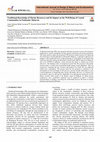
International Journal of Design & Nature and Ecodynamics, Jun 30, 2023
Traditional knowledge (TK) concerning the utilization of marine resources has long been employed ... more Traditional knowledge (TK) concerning the utilization of marine resources has long been employed by coastal communities for their general well-being and income generation. This study aimed to explore the potential of TK related to marine resources for enhancing the well-being of coastal populations in Peninsular Malaysia. A qualitative approach was adopted, with in-depth interviews conducted among 117 participants in the region. Data collection took place during the Movement Control Order (MCO) imposed in Malaysia due to the COVID-19 pandemic, which restricted the ability to conduct face-to-face interviews. The findings of this investigation revealed that TK associated with marine resources plays a crucial role in promoting health among coastal inhabitants. This was assessed by examining the key resources and purposes for which TK was employed within these communities. The present study has the potential to contribute to the development of new knowledge on TK practices, provide valuable information to assist coastal populations in augmenting their income and health, and serve as a reference for governments, agencies, and relevant stakeholders in recognizing the significance of TK. Future research could extend to the Borneo region of Malaysia to obtain diverse perspectives, and a quantitative approach may be employed to achieve a broader generalizability of findings concerning the relationship between TK based on marine resources and societal well-being.

Natural Hazards Review, Feb 1, 2023
Sea-level rise in response to climate change and global warming severely impacts coastal cities t... more Sea-level rise in response to climate change and global warming severely impacts coastal cities through increased soil erosion and other hazards. Therefore, simulating threats in coastal locations is critical for coastal city management and planning. The Nonlinear Autoregressive Exogenous-Neural Network (NARX-NN) was used in conjunction with the Bruun model and GIS methods to estimate the rate of sea-level rise, develop a coastal erosion model and coastal hazards maps, and simulate a sea-level increase with a maximum speed of 79.26 mm=year, and an average of about 25.34 mm=year, with a 1.48 m=year average erosion rate simulated from 2013 to 2020 along Merang kechil to Kuala Marang in Terengganu state coastal areas. According to the Bruun model, the areas most vulnerable to shoreline erosion are Kuala Nerus, Pendagan Buluh, and Kuala Ibai. Batu Rakit (Reach 1) has the highest rate of coastal erosion, at 28.16%, compared to 16.5 percent in Kuala Nerus (Reach 2) and 19.1% in Pengadang Buluh (Reach 3). The findings of this study might be utilized to build new coastal hazard erosion maps in a GIS framework, which could then be used as part of Malaysia's East Coast zone vulnerability assessment. The findings may also aid in the prioritization of conservation efforts in afflicted areas or the decision to adapt to the effects of coastal erosion. This article presents a methodological framework and an erosion management prioritization system to help coastal managers, planners, and developers identify hazardous zones and improve coastal management plans using geospatial models.
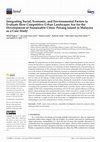
Land
The competitiveness of urban landscapes is a subject of growing attention as cities strive to bec... more The competitiveness of urban landscapes is a subject of growing attention as cities strive to become the best places to support enterprises, economic development, and high-quality living while preserving environmental resources. In evaluations of urban competitiveness, financial factors are frequently emphasized. In this systematic study for the future sustainable urban landscape (SUL), we use the instance of Penang Island, Malaysia, to present an integrated methodology for finding, evaluating, and validating good indicators for developing an urban landscape index that balances economic, sociocultural, and environmental factors. First, we provide a framework for developing such an index by developing a Delphi Analytical Hierarchy Process (DAHP) model that aids in choosing the most important aspects and sub criteria affecting the sustainability of urban landscapes. Then, under the Sustainable Development Goals (SDG), we demonstrate how to use these data to assess the competitiveness ...
Regional Studies in Marine Science

Cambridge Prisms: Coastal Futures
Coastal eutrophication and hypoxia remain a persistent environmental crisis despite the great eff... more Coastal eutrophication and hypoxia remain a persistent environmental crisis despite the great efforts to reduce nutrient loading and mitigate associated environmental damages. Symptoms of this crisis have appeared to spread rapidly, reaching developing countries in Asia with emergences in Southern America and Africa. The pace of changes and the underlying drivers remain not so clear. To address the gap, we review the up-to-date status and mechanisms of eutrophication and hypoxia in global coastal oceans, upon which we examine the trajectories of changes over the 40 years or longer in six model coastal systems with varying socio-economic development statuses and different levels and histories of eutrophication. Although these coastal systems share common features of eutrophication, site-specific characteristics are also substantial, depending on the regional environmental setting and level of social-economic development along with policy implementation and management. Nevertheless, e...
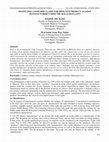
Prior to the promulgation of the Consumer Protection Act 1999 (CPA) in Malaysia, there are countl... more Prior to the promulgation of the Consumer Protection Act 1999 (CPA) in Malaysia, there are countless obstacles to bring action against manufacturer for defective product under the common law of tort. It was also almost impossible to impose direct liability on manufacturer based on contract due to the doctrine of privity of contract, which necessitates the claimant to have some sort of contractual relationship with the manufacturer, which are seldom. However, the enactment of CPA has brought some major changes in improving consumers’ right against manufacturer. Nevertheless, the question remains on to what extent have CPA lessened the difficulties. This paper generally explores the possible grounds to hold a manufacturer liable for producing defective product under the CPA. The specific objective of this paper is to examine major challenges that may impede consumers’ claim against manufacturer of defective product under contract, tort as well as the CPA. Recommendations for reform wi...

Sains Malaysiana
Terengganu Marine Parks (TMP) is a 591.37 km2 marine protected area. TMP are popular tourist dest... more Terengganu Marine Parks (TMP) is a 591.37 km2 marine protected area. TMP are popular tourist destinations that significantly generate revenue to the government and local businesses through tourism sector. However, the anthropogenic activities have contributed to TMP’s declining ecosystem health, particularly the coral reefs. Therefore, a sustainable ecosystem-based management is required to maintain the ecosystem. In this study, we identify issues related to the marine park’s governance, development on islands, tourist activities and coral health status in the TMP for assessing potential management strategy for conserving the ecosystem. The findings on management in TMP found that there is an overlapping in managing the marine park between the federal and state government. Unintegrated development to accommodate rising number of tourist and their activities in the marine parks are identified as the factors contributing towards degradation of the ecosystems. Relatively, reef areas cl...

International Journal of Sustainable Development and Planning
This study was conducted to analyse the practice of associated use of traditional knowledge (TK) ... more This study was conducted to analyse the practice of associated use of traditional knowledge (TK) on marine resources as new sources of wealth to enhance the economic well-being of the coastal communities. This study employed a qualitative research approach with a total of 117 respondents in Peninsular Malaysia. Convenience and purposive sampling methods were used to identify potential respondents and thematic analysis for the data analysis. The data was gathered through telephone interviews during the Movement Control Order (MCO) in Malaysia due to the COVID-19 pandemic. The results of the study reveal that the associated use of traditional knowledge on marine resources does play an essential role in the economic well-being of coastal communities. This was assessed through the perspective of living standards and livelihood improvement. The potential of TK based on marine resources illustrates the opportunity for this practice to become a valuable economic resource and create employm...
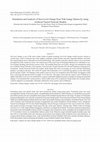
Sains Malaysiana
Sea level change is one of the most certain results of global warming. Sea level change would inc... more Sea level change is one of the most certain results of global warming. Sea level change would increase erosion in coastal areas, result in intrusion into water supplies, inundate coastal marshes and other important habitats, and make the coastal property more vulnerable to erosion and flooding. This situation coincides with the massive socio-economic development of the coastal city areas. The coastal areas of the East Coast of Peninsular Malaysia are vulnerable to sea-level change, flooding, and extreme erosion events. The monthly Mean Sea Level (MSL) change was simulated by using two Artificial Neural Network (ANN) models, Feed Forward- Neural Network (FF-NN) and Nonlinear Autoregressive Exogenous- Neural Network (NARX-NN) models. Both models did well in recreating sea levels and their fluctuating patterns, according to the data. The NARX-NN model with architecture (5-6-1) and four lag options, on the other hand, got the greatest results. The findings of the model's mean sea le...
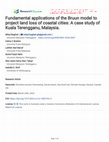
Shoreline erosion is a topic of high urgency in coastal cities that suffer from climate change in... more Shoreline erosion is a topic of high urgency in coastal cities that suffer from climate change induced sea-level rise and inundation. Knowledge is needed to protect ecologically sensitive coastal areas with high social and economic value such as the Kuala Terengganu area in Malaysia. The current study applies environmental geospatial modeling to evaluate the impact of changes in sea level on shoreline erosion in Kuala Terengganu. We present an analysis and framework for model formulation adopting the Bruun model for coastal areas that can serve as a blueprint for other studies. The goal was to assess the rate of shoreline erosion and to predict erosion based on changes in sea level. Key assumptions in the model include the beach profile and its equilibrium. We identified several areas at greatest risk for erosion including Kuala Nerus and Pengadang Buluh and discuss measures and challenges for erosion mitigation. The findings of this study can enhance the planning, policy, and decis...
Environmental Science and Pollution Research
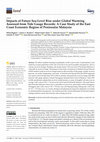
Land
The effects of global warming are putting the world’s coasts at risk. Coastal planners need relat... more The effects of global warming are putting the world’s coasts at risk. Coastal planners need relatively accurate projections of the rate of sea-level rise and its possible consequences, such as extreme sea-level changes, flooding, and coastal erosion. The east coast of Peninsular Malaysia is vulnerable to sea-level change. The purpose of this study is to present an Artificial Neural Network (ANN) model to analyse sea-level change based on observed data of tide gauge, rainfall, sea level pressure, sea surface temperature, and wind. A Feed-forward Neural Network (FNN) approach was used on observed data from 1991 to 2012 to simulate and predict the sea level change until 2020 from five tide gauge stations in Kuala Terengganu along the East Coast of Malaysia. From 1991 to 2020, predictions estimate that sea level would increase at a pace of roughly 4.60 mm/year on average, with a rate of 2.05 ± 7.16 mm on the East Coast of Peninsular Malaysia. This study shows that Peninsular Malaysia’s ...
Journal of Advanced Research in Dynamic and Control Systems, 2020

Sarawak Biodiversity Centre, 2008
This paper deals with international regimes on biodiversity impacting Malaysia‘s position as a bi... more This paper deals with international regimes on biodiversity impacting Malaysia‘s position as a biodiversity rich country. The Convention on Biodiversity (CBD) recognizes the sovereign rights of states to the exclusive use and control over their biodiversity resources. The CBD too expects access to these resources should be made available to others on mutually agreed terms (MAT) subject to prior informed consent (PIC) and on the basis of benefits sharing (BS). Thus ABS (access and benefit sharing) becomes a cornerstone of an international understanding on equitable sharing of the world resources between the technology rich nations and resource rich nations. Concerns have been raised by some that the ABS mechanism may be subverted by TRIPs patentability requirements. The DOHA Declaration and call by some states for inclusion of CBD into TRIPs including disclosure requirement in patent application under TRIPs are central to the current debates over the CBD-TRIPs interface. The Biosafety aspect of biotechnology essentially covered under the Cartagena Protocol obligates member countries in respect of biosafety. The Malaysia Biosafety Act exemplifies this obligation. All these issues are examined in the context of Malaysia‘s NBSAPS (National Biodiversity Strategies and Action Plan 1998)

Journal of East Asia and International Law, 2016
There are approximately 116 straits used for international navigation around the world. Some of t... more There are approximately 116 straits used for international navigation around the world. Some of them are important international maritime chokepoints, namely the Dover Strait, Hormuz Strait, Straits of Malacca and Singapore and the Russian straits across the Northeast Arctic Passage. Due to the high number of navigational traffic going through these straits, vessel-source pollution is endemic in these waters. This article examines the applicable international legal framework on protection of the marine environment of straits used for international navigation such as Part XII of the United Nations Convention on the Law of the Sea and other related legal measures like International Maritime Organization conventions on protection of the marine environment. This article concludes by stating that the present framework is not sufficient in properly balancing two vital interests in the maritime world-protection of the marine environment vis-à-vis shipping.
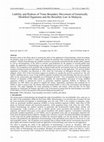
Journal of Sustainable Development, 2011
Biosafety refers to the efforts taken in ensuring the safety of the application of biotechnology,... more Biosafety refers to the efforts taken in ensuring the safety of the application of biotechnology, which necessitates for proactive steps to be taken to "reduce and eliminate the potential risks resulting from biotechnology and its products". Modern biotechnology has enabled scientists to genetically and biochemically modify plants, animals as well as microorganisms. In the effort to increase crop production for the purpose of securing global food supply, the application of biotechnology in the agricultural sector must be carried out in a safe and sustainable manner. The recognition of the potential risks to human health and the environment must not be discounted and countries looking towards the application of biotechnology must ensure its safe application. The need for further regulations on biosafety was discussed in 1992, when the Convention on Biological Diversity (CBD) was adopted. Article 19(3) of the Convention requires its members to consider the need for a protocol on "the safe transfer, handling and use of any living modified organism resulting from biotechnology that may have adverse effect on the conservation and sustainable use of biological diversity." This consequently led to the Cartagena Protocol on Biosafety (CPB), which primarily regulates the trans-boundary movement of living modified organisms (LMOs) or alternatively known as genetically modified organisms (GMOs). In Malaysia, the Biosafety Act 2007 (BSA) was passed to regulate the release, importation, exportation and contained use of GMOs in order to protect inter alia human, plant and animal health as well as the environment and biological diversity. This paper highlights the issues pertaining to liability and redress, which provides for the legal obligation to compensate the damage especially to the environment accruing from the trans-boundary movement of the GMOs, as well as the position of the present Malaysian biosafety law.
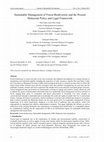
Journal of Sustainable Development, 2012
Forest biodiversity is crucial not only in the socioeconomic and industrial development of a coun... more Forest biodiversity is crucial not only in the socioeconomic and industrial development of a country but also in maintaining environmental stability including the protection of water resources, and the flora and fauna. Under the Convention on Biological Diversity (CBD), forest biological diversity is a broad term that refers to all the life forms found within forested areas and the ecological roles they perform encompassing not just trees but the multitude of plants, animals and microorganisms that inhabit forest areas and their associated genetic diversity. Forest management and conservation are continuously evolving to manage and conserve forests effectively and to address the causes of deforestation and biodiversity loss. Sustainable forest management involves activities at levels ranging from genes to ecosystems and forest conservation is becoming ever more complex as conservationists attempt to understand and accommodate the needs and rights of people who live in and around forests. Amongst all kinds of ecosystems, tropical rainforests ecosystem and wetland and mangrove ecosystem, both of which constitute the Malaysian forests, are the most species-rich. For sustainable management of forest biodiversity of its forest biodiversity, Malaysia is in dire need of sufficient laws and policies, which will subsequently be translated into effective administrative measures. This paper highlights the efficacy as well as sufficiency of the existing Malaysian laws and policies in managing forest biodiversity in a sustainable manner by comparatively looking into the requirement of CBD as an international regime for sustainable biodiversity management and conservation.










Uploads
Papers by WAN IZATUL ASMA WAN TALAAT